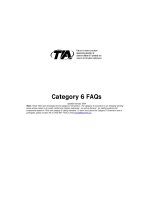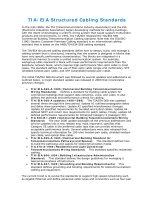Tài liệu Cabling Standard - TIA 606 - Administration Standard for the Telecommunications Infrastructure of ppt
Bạn đang xem bản rút gọn của tài liệu. Xem và tải ngay bản đầy đủ của tài liệu tại đây (141.26 KB, 20 trang )
ANSI/TIA/EIA-606
Administration Standard for the
Telecommunications Infrastructure of
Commercial Buildings
Disclaimer
This information is collected and composed by QUANG DUNG TECHNOLOGY from www.Cablingdb.com. All
information is copyrighted by Cablingdb.com.
Standards Preservation
This section is not part of the original standards documentation. The purpose of this document is to provide
an easy to understand, condensed version of the original document. A basic level of telecommunications is
assumed. For further information on terms and definitions see our Glossary of Terms section. Whether you
are renovating your existing cable plant or installing a new one, Cablingdb.com urges you to investigate a
standards based solution. This document is not meant to replace the original standards developed by the
various standards bodies and we urge you to purchase the original documents through www.tiaonline.com.
AUTHORIZED & EXCLUSIVE DISTRIBUTOR
Head Office
Suite 202, The Colonnade Building, 27 Nguyen Trung Truc St.,
District 1, Hochiminh City, Vietnam
Tel: 84.8 823-1693 Fax: 84.8 823-1665
Hanoi Office
A11, 3/Fl., Horizon Hotel, 40 Cat Linh St.,
Dong Da District, Hanoi, Vietnam
Tel: 84.4 736-7055 Fax: 84.4 733-2470
Website: www.qd-tek.com.vn
Email:
ANSI/TIA/EIA 606 Administration Standard for the Telecom Infra. of Com. Bldgs
Quang Dung Technology Distribution Company Page 2 of 20
Table of Contents
ADMINISTRATION CONCEPTS
Identifiers
Labeling
Records
Linkages
User Code
PRESENTATION OF INFORMATION
Reports
Drawings
Conceptual Drawings
Installation Drawings
Record Drawings
Work Orders
PATHWAY & SPACE ADMINISTRATION
Identifiers
Pathway Identifiers
Pathway Labeling
Space Identifiers and Labeling
Records
Pathway Records
Space Records
Reports
Pathway Reports
Space Reports
Drawings
Work Orders
WIRING SYSTEM ADMINISTRATION
Identifiers
Cable identifiers
TERMINATION HARDWARE IDENTIFIERS and LABELING
Termination Position Identifiers and Labeling
Splice Closure Identifiers and Labeling
RECORDS
Cable Records
Termination Hardware Records
User Code
Splice Records
LINKAGE ADMINISTRATION
Splices With One Cable
Splices With Separate Cable Identifiers
REPORTS
ANSI/TIA/EIA 606 Administration Standard for the Telecom Infra. of Com. Bldgs
Quang Dung Technology Distribution Company Page 3 of 20
Cable Summary Report
End-to-End Circuit Report
Cross-connect Report
Drawings
Work Orders
GROUNDING AND BONDING ADMINISTRATION
INDENTIFIERS
Grounding and Bonding Identifiers
Grounding and Bonding Labeling
RECORDS
TMGB Record
Backbone Bonding Conductor
TGB Records
Pathway Records for Grounding
Reports
Drawings
Work Orders
LABELING AND COLOR CODING
Labels
Adhesive Labels
Insert Labels
Other Labels
Bar Coding
COLOR CODING of TERMINATION FIELDS
Color Coding Rules
Colors
ANSI/TIA/EIA 606 Administration Standard for the Telecom Infra. of Com. Bldgs
Quang Dung Technology Distribution Company Page 4 of 20
ADMINISTRATION CONCEPTS
This section deals with the elements of a telecommunications system as they relate to
the administration of that system including the pathways, spaces, grounding and
bonding.
Identifiers
Definition: An identifier is used in labeling telecommunications infrastructure components such
as cable, racks, telecommunications rooms, equipment rooms, pathways and
telecommuncations outlets.
It is a unique set of number, letters or a combination of both that are not repeated within the
administration of the system.
Identifiers are inserted into the adminstrative database and onto a label which is affixed to the
component.
Shall be:
• marked at the element to be administered
• unique eg: no cable identifier should be the same as a pathway identifier.
Identifiers may be encoded or un-encoded. An un-encoded identifier contains
information specific only to the element identified, eg: C-001 could be a cable
designated as 001. But a piece of termination hardware may be identified as 4A-B12
which would be termination hardware in closet 4A, on column (possibly a rack) B,
Patch Panel 12.
Labelling
Definition: Labeling is the marking of an element of a telecommunications infrastructure with
the appropriate identifier and other relevant information.
Labeling may occur in two ways. Labels may be securely attached to the element, or, the
element itself may be marked directly.
Labeling shall be:
• affixed to the element to be administered or
• marked directly on the element being administered.
See section 8.2 of the original standards documentation for labeling requirements.
Records
Definition: A record is a grouping of information about a specific element of a
telecommunications system. The record will also contain the linkages to other elements of the
telecommunications system.
The record will be contained in a database which may be searched and sorted according to the
requirements of the users.
There is information which is required and information which is optional.
Table 1 is an example of a cable record.
Cable records may contain information about termination positions, the pathway it is
located in, and the space it is located. For example, the cable record shown in Table 1
has it in pathway CP12, terminating in closet 4C, on rack B12, position 001.
There are 4 categories of information referred to in the standard, they are:
• Required Information
• Required Linkages
ANSI/TIA/EIA 606 Administration Standard for the Telecom Infra. of Com. Bldgs
Quang Dung Technology Distribution Company Page 5 of 20
• Optional Information
• Other Linkages
As a minimum requirement, all records shall contain the Required Information and
Required Linkages.
The "comments" section is not a required part of the standard, but are included for
clarity. It is used within this document to help the reader understand the example
being shown.
Table 1: An example of a Cable Record
Sample Data
Comment
Required Information
Cable Identifier
C0001
Cable Type
4 pr UTP Category 5e
description of cable
Unterminated Pair/Cond
0
list of unterminated pairs or
conductors
Damaged Pair/Cond
0
list of damaged pairs or
conductors
Available Pair/Cond
0
list of available pairs or
conductors
Required Linkages
End 1
End 2
Pr 1-4, Term pos record
J0005
4C-B12-001
the element each end of the
cable is connected to
Splice Record
n/a
Pathway Record
CP-12
the pathway the cable is
located in
Grounding Record
n/a
Optional Information
Cable Length
75 meters
UPC
n/a
Ownership
Smith
ANSI/TIA/EIA 606 Administration Standard for the Telecom Infra. of Com. Bldgs
Quang Dung Technology Distribution Company Page 6 of 20
Other Information
Other Linkages
Equipment Records
PC120
the equipment the cable
terminates at (desk top)
Other Linked Records
Linkages
• are the connections between records and identifiers.
• occur when an identifier from one record "points" to another record
For example a cable identifier may show where each end of that cable terminates.
User Code
Definition: In administration of a telecommunications system, a user code is a unique way of
identifying a particular user location.
The code may be an extension number, office or work area number, or other numbering
scheme designed by the owner, installer or engineer.
This user code is input into the telecommunications data base for later use.
The user code provides the administrator with easy to understand code that will point
to a specific office, account, telephone number or person. For example, an outlet
labeled O-112 may be located in Office 230. In this case the location of Office 230 is
much more readily understood than O-112. This aids in moves, adds and changes.
PRESENTATION OF INFORMATION
A typical administration system includes:
• Labels
• Records
• Reports
• Drawings
• Work orders.
Reports
Reports detail information about the telecommunications infrastructure records. The
information may be all of the information about the record, or it may be selected
information. The way in which the information is extracted will depend on its input
into the cable database. For example, a report may detail the cable id, the pathway it
is located in and its cable type. This information may then be sorted however the user
wants.
DRAWINGS
Drawings are used to illustrate different stages of telecommunications infrastructure
planning and installation. Annex C of the original standards documentation provides
symbols that may be used in drawings.
ANSI/TIA/EIA 606 Administration Standard for the Telecom Infra. of Com. Bldgs
Quang Dung Technology Distribution Company Page 7 of 20
Conceptual Drawings
Conceptual drawings are used to convey the proposed design intent. They do not
include the elements and identifiers and do not necessarily have to become part of
the administration documentation.
Installation Drawings
Installation drawings are more detailed than the conceptual drawings and are used to
document the telecommunications infrastructure to be installed. They should include
the infrastructure elements and may also describe the installation methods. It is not
necessary to provide identifiers on these drawings.
Record Drawings
Record drawings document the installed telecommunications infrastructure including:
• Floor plans
• Elevation
• Detail drawings
Record drawings are site specific and will have identifiers assigned to key elements.
There may be separate drawings for other portions of the infrastructure such as
pathways and spaces depending on how complex the installation is.
WORK ORDERS
Work orders document the operations needed to implement changes affecting the
telecommunications infrastructure such as:
• moving a patch cord
• installing a conduit
• relocating an outlet box.
and involve either individually or in combination:
• spaces
• pathways
• cables
• splices
• terminations
• grounding
Personnel responsible for the work and for the documentation should also be listed.
The original standards documents contain several examples of the various types of
reports available.
ANSI/TIA/EIA 606 Administration Standard for the Telecom Infra. of Com. Bldgs
Quang Dung Technology Distribution Company Page 8 of 20
PATHWAY & SPACE ADMINISTRATION
Pathways are the components of a telecommunications system that route media from
one point to another. Spaces are the areas of a telecommunications system where
equipment is located.
Pathway and space administration relates directly to the pathways and spaces
identified in ANSI/TIA/EIA 569.
When joining two or more pathways of different types or sizes, each segment shall be
administered as a separate pathway.
IDENTIFIERS
Pathway Identifiers
Shall:
• be unique and assigned to each pathway which serves as a link to the
pathway record.
• be marked on each pathway or on the pathway labels.
• be assigned to each section of a partitioned pathway such as a duct bank.
Pathway Labeling
Pathways shall be:
• labeled at all endpoints located in telecommunications rooms, equipment
rooms or entrance facilities.
• labeled at regular intervals in a closed loop environment.
• labeled at the each end point where there are intermediate points with 3 or
more pathway endpoints such as pull boxes and joined tray segments. The
main pathway should be assigned an identifier such as 1A400 and its 3
partitions assigned 1A400-a, 1A400-b and 1A400-c.
Space Identifiers and Labeling
A unique identifier shall be assigned to each space.
All spaces shall be labeled. Labels should be placed at the entry to the space, eg: on
the door of the telecommunications room.
RECORDS
Pathway Records
Contain pathway:
• identifier
• type
• fill
• loading
Link to:
• Cable records
• Space records, both ends
• Space record access
• Other pathway records









